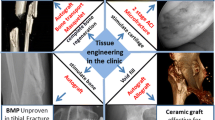Summary
Faulty osteoclasts, characteristic of the incisors-absent (ia) rat mutation of osteopetrosis, cause a resorptive defect which results in the persistence of immature, highly mineralized bone matrix. We implanted osteopetrotic bone subcutaneously into normal andia rats to determine ifia bone could induce functionally active and morphologically identifiable osteoclasts at the implant surface. Assays of45Ca released from the preparations showed that normal andia recipients were capable of equivalent cell-mediated release of Ca over a 2-week implant period, indicating that theia resorptive defect was not reproduced at the subcutaneous site. Freeze-thawed osteopetrotic bone released twice as much45Ca as normal bone. This difference was eliminated by collagenase treatment. Cellular profiles were similar in both normal andia animals regardless of the implant preparation. At 3 days after implantation, both bone and suture were surrounded by mononuclear cells. By 14 days, multinucleated cells appeared at the implant surfaces. Morphological comparison of implant-induced multinucleated cells and tibial osteoclasts indicated that bone-elicited multinucleated cells lacked the ruffled borders characteristic of normal osteoclasts or the extensive clear zones typical ofia osteoclasts, but more closely resembled suture-induced macrophage-polykaryons. We conclude that ectopically implantedia bone as compared to normal bone elicits a different functional response from structurally similar cell populations. Bone-elicited multinucleated cells could not be classified as active osteoclasts despite evidence of release of45Ca. Release of labeled Ca was probably due to the action of mononuclear phagocytes and macrophage-polykaryons rather than to osteoclastic resorption.
Similar content being viewed by others
References
Boskey AL, Marks SC (1985) Mineral and matrix alterations in the bones of incisors-absent (ia/ia) osteopetrotic rats. Calcif Tiss Int 37:287–292
Burger EH, Van der Meer JWM, Nijweide PJ (1984) Osteoclast formation from mononuclear phagocytes: role of bone forming cells. J Cell Biol 99:1901–1906
Chambers TJ, Fuller K (1985) Bone cells predispose bone surfaces to resorption by exposure of mineral to osteoclast contact. J Cell Sci 76:155–165
Chambers TJ, Horton MA (1984) Failure of cell of the mononuclear phagocyte series to resorb bone. Calcif Tiss Int 36:556–558
Chambers TJ, Thomson BM, Fuller K (1984) Effect of substrate compsition on bone resorption by rabbit osteoclasts. J Cell Sci 70:61–71
Chambers TJ, Darby JA, Fuller K (1985) Mammalian collagenase predisposes bone surfaces to osteoclastic resorption. Cell Tissue Res 241:671–675
Glowacki J, Altobelli D, Mulliken JB (1981) Fate of mineralized and demineralized osseous implants in cranial defects. Calcif Tiss Int 3:71–76
Green M, Isaac DH, Jenkins GM (1985) Bone microstructure by collagenase etching. Biomaterials 6:150–152
Greep RO (1941) An hereditory absence of the incisor teeth. J Hered 32:397–398
Holtrop ME, Cox KA, Glowacki J (1982) Cells of the mononuclear phagocyte system resorb implanted bone matrix: a histologic and ultrastructural study. Calcif Tiss Int 34:488–494
Horton MA, Rimmer EF, Lewis D, Pringle JAS, Fuller K, Chambers TJ (1984) Cell surface characterization of the human osteoclast: phenotypic relationship to other bone marrow derived cell types. J Pathol 144:281–294
Kahn AJ, Stewart CC, Teitelbaum SL (1978) Contact-mediated bone resorption by human monocytes in vitro. Science 199:988–990
Malone JD, Teitelbaum SL, Griffin GL, Senior RM, Kahn AJ (1982) Recruitment of osteoclast precursors by purified bone matrix constituents. J Cell Biol 92:227–230
Marks SC (1973) Pathogenesis of osteopetrosis in theia rat: reduced bone resorption due to reduced osteoclast function. Am J Anat 138:165–189
Marks SC (1983) The origin of osteoclasts: evidence, clinical implications and investigational challenges of an extraskeletal source. J Oral Pathol 12:226–256
Marks SC (1984) Congential osteopetrotic mutations as probes of the origin, structure and function of osteoclasts. Clin Orthop 189:239–263
Marks SC, Walker DG (1976) Mammalian osteopetrosis-a model for studying cellular and humoral factors in bone resorption. In: Bourne G (ed) The Biochemistry and Physiology of Bone. Academic Press, New York, pp 227–301
Mundy GR, Altman AJ, Gondek MD, Bandelem JG (1977) Direct resorption of bone by human monocytes. Science 196:1109–1110
Mundy GR, Varane J, Orr W, Gondek MD, Ward PA (1978) Resorbing bone is chemotactic for monocytes. Nature 275:132–135
Teitelbaum SL, Kahn AJ (1980) Mononuclear phagocytes, osteoclasts and bone resorption. Min Electrolyte Metab 3:2–9
Teitelbaum SL, Stewart CC, Kahn AJ (1979) Rodent peritoneal macrophages as bone resorbing cells. Calcif Tiss Int 27:255–261
Walters LM, Schneider GB (1985) A functional and morphological study of cells adjacent to ectopic bone implants in rats. Am J Anat 173:287–297
Author information
Authors and Affiliations
Rights and permissions
About this article
Cite this article
Walters, L.M., Schneider, G.B. Cellular response to ectopically implanted silk sutures and osteopetrotic bone. Cell Tissue Res. 248, 79–88 (1987). https://doi.org/10.1007/BF01239966
Accepted:
Issue Date:
DOI: https://doi.org/10.1007/BF01239966




